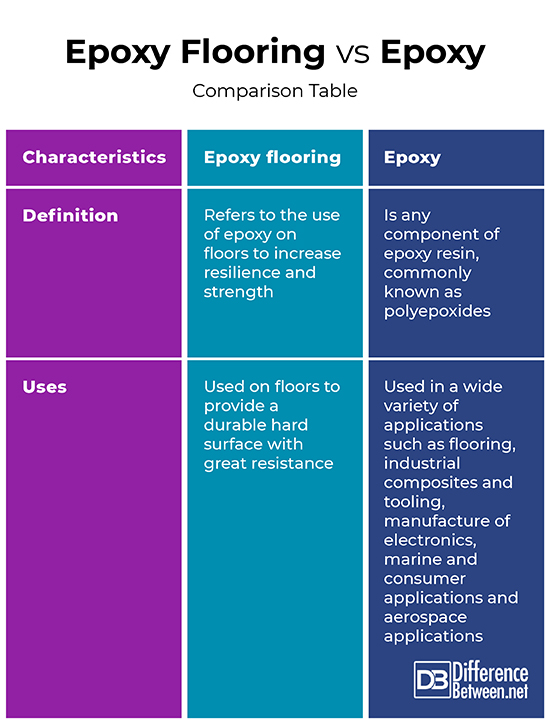Difference Between Epoxy Flooring and Epoxy
Epoxy is quite popular in the construction industry. Both commercial painters and contractors as well as people who prefer DIY are among the major users of epoxy. First used for concrete restoration in the early 1950s, epoxy is now used in different coatings mainly flooring and painting. It is preferred since it is hygienic, skid-resistant, conducive and electrostatic dissipative. Here, we will look at the difference between epoxy flooring and epoxy.

What is Epoxy Flooring?
Epoxy flooring is the use of epoxy on floors to increase resilience and strength.
Here are some benefits of epoxy flooring
- Bond to concrete- This is one of the best methods of bonding to concrete. This is because they create an adhered system base that allows topcoats and subsequent build.
- Build thickness- Epoxy flooring builds thickness such that it seals cracks and minor concrete blemishes. However, you may need to build more coat applications to get the desired performance requirements.
- End performance- Epoxy flooring provides a durable hard surface with great resistance.
- It is easy to install
- The durability of epoxy floors is unmatched. This is because the epoxy resin is resistant to stain, scuff, heat and scratch. It is also able to withstand heavy loads. As such, epoxy floors do not crack hence saving on repair, replacement and maintenance costs.
- Ease of cleaning- Epoxy floors repel grease, oil and water. It is also easy to sweep dust and dirt not forgetting mildew resistance.
- It is easy to customize- Users can add colour schemes and even gloss shine.
- Epoxy floors are anti-slip. This helps prevent accidents that would otherwise occur with slippery floors.
However,
Epoxy floors:
- Are sensitive to UV light. You may notice the color change to yellow or amber over time.
- They are not good chemical-resistants’ or abrasives

What is Epoxy?
This is any component of epoxy resin, commonly known as polyepoxides.
These resins can either be reacted with other co-reactants such as acids, polyfunctional amines, alcohols and phenols or by themselves in a process known as curing.
Epoxy-based materials are extensively used in adhesives, coatings and composite materials. Epoxy coatings are essential in automotive and industrial applications as they are more heat resistant as compared to latex-based paints.
However, they fade due to exposure to UV.
Among the uses of epoxies include:
- Residential and commercial flooring
- Used in the construction of a wide variety of materials such as boast, bicycles and other automobiles due to their adhesive nature
- Industrial composites and tooling
- Used in the manufacture of electronics
- Used in marine and consumer applications
- Used in aerospace applications
Differences between Epoxy Flooring and Epoxy
Definition
Epoxy flooring refers to the use of epoxy on floors to increase resilience and strength. On the other hand, epoxy is any component of epoxy resin, commonly known as polyepoxides.
Uses
Epoxy flooring is used on floors to provide a durable hard surface with great resistance. On the other hand, epoxy is used in a wide variety of applications such as flooring, industrial composites and tooling, manufacture of electronics, marine and consumer applications and aerospace applications.
Epoxy Flooring vs. Epoxy: Comparison Table

Summary of Epoxy Flooring vs. Epoxy
Epoxy flooring is used on floors to provide a durable hard surface with great resistance. On the other hand, epoxy is used in a wide variety of applications such as flooring, industrial composites and tooling, manufacture of electronics, marine and consumer applications and aerospace applications.
- Difference Between Profit Center and Investment Center - July 2, 2022
- Difference Between Anti-Trust and Anti-Competition - June 6, 2022
- Difference Between Stocktaking and Stock Control - June 6, 2022
Search DifferenceBetween.net :
Leave a Response
References :
[0]Clayton May. Epoxy Resins: Chemistry and Technology, Second Edition,. CRC Press.https://books.google.co.ke/books?id=b2zipv8_yQUC&pg=PA761&dq=Difference+between+Epoxy+Flooring+and+Epoxy&hl=en&sa=X&ved=2ahUKEwijhrCJ4I_vAhXLSTABHZZmCNQQ6AEwBXoECAIQAg#v=onepage&q=Difference%20between%20Epoxy%20Flooring%20and%20Epoxy&f=false
[1]Faris Yılmaz. Aspects of Polyurethanes. Books on Demand, 2017. https://books.google.co.ke/books?id=GemPDwAAQBAJ&printsec=frontcover&dq=Difference+between+Epoxy+Flooring+and+Epoxy&hl=en&sa=X&ved=2ahUKEwj5xfiX4I_vAhUvrFkKHW9DBek4ChDoATADegQIAhAC#v=onepage&q&f=false
[2]Hinze J & Smith J. Construction Management: Subcontractor Scopes of Work. CRC Press, 2009. https://books.google.co.ke/books?id=fA3LBQAAQBAJ&pg=PA243&dq=Epoxy+Flooring&hl=en&sa=X&ved=2ahUKEwjF64XS4Y_vAhWnzlkKHWQdA1w4ChDoATAFegQIBhAC#v=onepage&q=Epoxy%20Flooring&f=false
[3]Image credit: https://commons.wikimedia.org/wiki/File:Epoxy.jpg
[4]Image credit: https://live.staticflickr.com/65535/50266986023_db94fa1636_b.jpg
